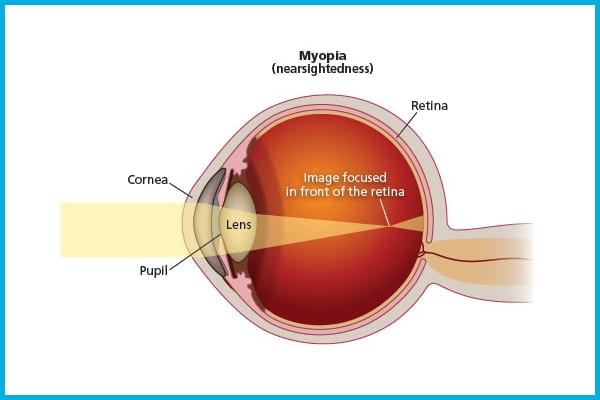
Myopia : An Introduction
This chapter is a part of Myopia series. The entire series will include multiple chapters about Adult and Childhood Myopia, Myopia progression, practical approach to halt myopia progression in children and so on.
Refractive Error or Ametropia is a condition when the rays of light cannot directly focus in the retina. It focuses either in front of the retina or behind the retina.
Ametropia consists of Myopia, Hypermetropia & Astigmatism. Many studies conducted across the globe about refractive errors has always shown that Myopia is the commonest and highly spread error.
The term myopia was invented back in 550 AD by then World Congress of Ophthalmology. Myopia is a Greek word which means “Close the eye”. According to WHO, it has come across a long way to effect around 1.89 billion people worldwide and if the same prevalence rate continues, the projections is that it might affect 2.56 billion people at the end of year 2020.
What is Myopia?
Myopia or Shortsightedness is a commonest form of Refractive Error (RE) where person is not able to see the distance able clear but has a clear near vision. Here distance means beyond 3 feet and near means at reading distance i.e. 35-40 cm.
Clinical definition of Myopia is “Rays of light coming from infinity cannot focus in the retina, instead it is focused in-front of the retina, when accommodation function is at rest”.
Characteristic of Myopia:
The major effect of myopia is that the patient is unable to see the distance image clearly. If explained practically, patient with myopia may have difficulty to see the bottom scroll in the TV or scores in cricket & football match from certain distance. Normal people who doesn’t have any kind of Refractive Error can easily read those from normal distances. Also, people may not recognise friends/relatives of theirs from 5 feet or beyond when they have significant amount of Myopia.
Signs & Symptoms:
Symptoms:
- Poor Distance vision
- Asthenopic symptoms in small degree of myopia
- Half shutting of the eyes may be complained by parents of the child. The child does so to achieve the greater clarity of stenopaeic vision
- Frontal Headache
- Irritation
Signs:
- Blurring of vision in distance
- Prominent eyeballs, myopic people tend to have bigger eyes
- Anterior chamber is deep than normal
- Against the motion glow in retinoscope
- Retinal changes are generally seen in moderate to high myopes
Types of Myopia:
Myopia is broadly classified into Two Types:
- Clinical Classifications
- Etiological Classifications
Based on the clinical classifications Myopia can be sub-classified into following:
- Congenital Myopia is a type of myopia which is present since birth, though usually diagnosed in 2-3 years of age.
- Simple or Development myopia is a commonest type of myopia. It is usually a physiological error and not associated with any other diseases. Its starts from young age and may persistently increase with the age of patient.
- Pathological Myopia is also known as degenerative/progressive myopia. It is rapidly progressive error which starts in childhood at 5-10 years of age and usually associated with degenerative changes in the Retina. Usually it is associated with heredity. The power is usually more than -5.00 diopter.
- Acquired Myopia is a condition where Myopia occurred due to some other factors like Drug induced, post-keratitic, post-traumatic, Pseudo-myopia or any other conditions.
Based on Etiological Classifications, Myopia can be sub classified into following:
- Axial Myopia: It is due to increase in the axial length of the eye. Axial length is the anterio-posterior length of the eye the ball. It is the commonest form of Myopia.
- Curvatural Myopia: It occurs when the curvature of the cornea or lens or both becomes more steep than normal.
- Positional Myopia: It is when the lens inside the eye comes forward from its original position.
- Index Myopia: It occurs when the refractive index of the lens increases due to various reasons, the common reason is nuclear cataract.
- Pseudo Myopia: When there is excessive accommodation due to prolong near work, transient blurry ness of vision in distance.
Management:
- Optical Management: The easiest, cheapest and commonest way to correct Myopia is optical correction.
- Spectacles glasses are most widely used remedy for it. Appropriate concave lens corrects myopia.
- Contact lens are another solution to correct myopia as an optical correction. Though contact lenses are not widely used as spectacles but still is broadly wore across the world. It is a temporary solution to get rid of glasses.
- Implantable contact lens (ICL): Implantable contact lens are another option to correct myopia. In this, ICL is placed inside the eye by an expert eye surgeon.
- Laser Treatment: Due to advancement of technology in recent years, LASIK laser treatment has now gained popularity among the people. Computer operated Excimer laser machine reshapes the cornea in such a way that the error gets corrected. It is said to be permanent treatment to eliminate myopia, though there are fewer risks involved within it. The main risk or side effects of the Laser surgery includes but not limited to Post Lasik Ectasia, over or under correction of the error, severe dry eyes among others. Good thing about these side effects are, they are treatable with certain medications and/or with surgical procedures.
In the next chapter, we shall discuss about Myopia in kids, symptoms, preventive measures for progression, treatment modalities and so on for children.







